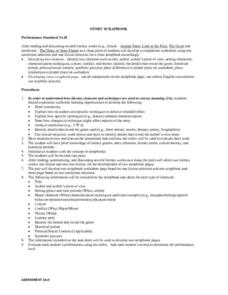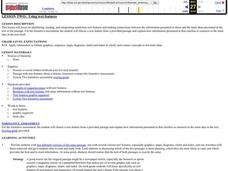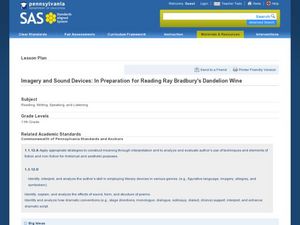K20 LEARN
Voices from the Past: History and Literature
Art can enhance the understanding of history. That's the big idea in a lesson that has young scholars read Randall Jarrell's poem "The Death of the Ball Turret Gunner" and an excerpt from John Hersey's Hiroshima, which provide a...
Utah Education Network (UEN)
Know Your Literature Genres
Open the library for young readers by introducing them to the main genres and sub-genres. A podcast and two presentations identify the characteristics of the different genres. Groups then sort through a box of books and, using evidence...
Curated OER
Rachel's Life is in a Hole
Explore how lack of access to water impacts peoples' lives in poor countries. Through text reading and discussion, middle schoolers are presented with the story of a young girl who lives and functions with limited water resources. They...
ReadWriteThink
Captioning the Civil Rights Movement: Reading the Images, Writing the Words
Scholars boost their knowledge of the Civil Rights Movement with a instructional activity that challenges writers, readers, and historians to analyze primary sources and caption their observations. By way of reading, writing, discussion,...
ReadWriteThink
"Three Stones Back": Using Informational Text to Enhance Understanding of Ball Don't Lie
"Three Stones Back," a passage from Matt de la Pena's best-seller, Ball Don't Lie, allows readers to practice their close reading skills as they compare the passage to an information text about wealth inequality.
Curated OER
Abigail and John in Love
The second lesson in the series asks groups to analyze an exchange of love letters between Abigail and John Adams. Scholars identify the many allusions and references in the letters and consider what they can infer about the writers.
Curated OER
Abigail at Seventeen
Young historians analyze a letter 17-year-old Abigail Adams wrote to her cousin and identify the aphorism Adams used. Participants select a line from the letter and create an illustration of the aphorism.
Curated OER
Sequencing
Young scholars consider how cause and effect translate into sequencing in literary works. In this sequencing lesson, students read non-fiction passages about Eleanor Roosevelt and Clara Barton. Young scholars complete graphic organizers...
Curated OER
Constitution and the Bill of Rights
Fourth graders explore the information of the index of the Constitution. In this Constitution and Bill of Rights lesson, 4th graders complete a worksheet by locating keywords in the index. Students understand the importance of using an...
Curated OER
Story Scrapbook
Pupils develop a comparison worksheet using one non fiction book and one fiction book they have read to be put into a class scrapbook. In their comparison students must have title, author, point of view, setting, characters, and other...
Pennsylvania Department of Education
Stories? Information? What's the Difference?
Students listen to a power point presentation to distinguish between fiction and nonfiction text. In this what's the difference lesson, students identify fact from opinion within a text. Students listen critically and respond to text.
Curated OER
Non-fiction Book Report
In this book report worksheet, students fill in information about a nonfiction book. Students include the topic, 4-5 facts already know, 6 new words learned, and 5-6 things they learned about the topic. Students also write about the...
Curated OER
The Planet Mars
Fifth graders gain knowledge about Mars and Earth. In this compare and contrast lesson, 5th graders use visual representations of the solar system to observe the characteristics of the planets. Students read fiction and nonfiction...
Curated OER
Publisher Brochures
Students create brochures on subjects they are studying in Publisher. For this nonfiction writing lesson, students use Publisher to create a brochure telling all the main ideas of a topic they are studying. Students use text boxes, fonts...
Curated OER
Very Good Facts About Very Good Books
Young scholars identify the characteristics of fiction and non-fiction texts. In this genre study lesson, students read the books A Butterfly Alphabet Book and I Wish I Were a Butterfly. Young scholars develop a graphic organizer to...
Curated OER
Using Text Features
Fourth graders read a nonfiction story that is presented to them with graphic features, and presented to them with only the text. In this text features lesson, 4th graders decide what the benefits of text organizers are and create...
Curated OER
Lesson 2: Fiction
What makes a book fiction or nonfiction? Kindergartners discover ways to find out if a book is real or made up. They examine a fictional picture book as a group and decide what clues help them decide. There is an independent worksheet...
Curated OER
Lesson 1: Real People
A biography is a factual book or narrative about a real person. The book, The Story of Ruby Bridges is used to introduce non-fiction texts about real people and event to a Kindergarten class. A chart is used to highlight text...
Curated OER
Natural Disasters: An Adventure in Non-Fiction
Students study different natural disasters. In this natural disaster lesson students read a nonfiction book followed by a discussion, an experiment, then collect illustrations from their experience.
Curated OER
Imagery and Sound Devices: In Preparation for Reading Ray Bradbury's Dandelion Wine
Twelfth graders analyze Ray Bradbury's use of techniques and elements of fiction as well as nonfiction in the novel Dandelion Wine. In this novel analysis lesson, 12th graders analyze the sensory techniques in Dandelion Wine. Students...
2012 Teaching Resources
Analyzing Character Traits
Character analysis becomes easy with a 24-page packet packed with mini-lessons, graphic organizers, and activities. A must-have for your curriculum library.
Curated OER
LPS Nonfiction and Research Follow-Up CRT Project
Students read different types of literature in a group setting. They discuss the related themes and research them. They create a PowerPoint presentation on the information they have collected.
Curated OER
Inventing and Presenting Unit 1: Analyzing Nonfiction and Inventing Solutions
Students read about and identify patterns in the invention process. Students discuss and write about information learned from research. Students compile a list of problems, choose one, write a problem statement, and compile a list of at...
Curated OER
Putting the Truth in Writing
Students define "nonfiction" and describe what they view as the best pieces of nonfiction writing. They determine criteria to evaluate whether or not a piece of nonfiction writing is good, and list categories of nonfiction writing.
Other popular searches
- Nonfiction Book Reports
- Nonfiction Text
- Summarizing Nonfiction
- Fiction and Nonfiction
- Fiction or Nonfiction
- Nonfiction Reading
- Nonfiction Text Features
- Nonfiction Text Structure
- Nonfiction Books
- Nonfiction Reading Skills
- Nonfiction Writing
- Nonfiction Literature























